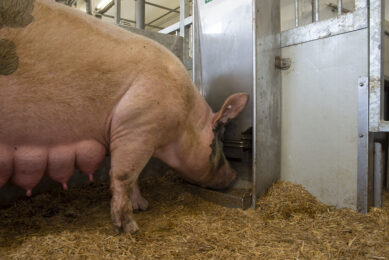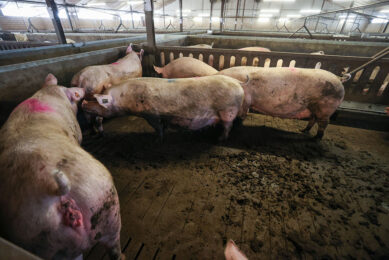Bone mineral density affects lameness in boars

Researchers from China explored the relationship between claw lesion types, bone mineral density, and lameness in boars. They also investigated the risk factors affecting bone mineral density.
Lameness in boars is a major production disease. The top 3 causes of lameness in pigs include claw lesions, osteoarthritis, and osteochondrosis. Bone mineral density is the amount of minerals per unit of bone volume which reflects bone health. It can be used as an additional tool to predict lameness. A better understanding of the effects of bone mineral density is warranted to identify novel therapeutic strategies for lameness.
Data collection
The research team selected 739 Duroc boars with an average age of 22 months. They placed 375 boars in individual pens, and 364 boars in individual stalls with a slatted concrete floor. The same person examined claw lesions of boars to minimise variability. The lesions observed included white line, toe, cracked wall vertical, dew claws, heel-sole crack, swelling ankle, cracked wall horizontal, and heel overgrowth and erosion overgrowth.
The team scored the lesions of the front and hind feet from 0 to 3 ranging from normal to severe lesions. They evaluated lameness using a scoring system from 0 (not lame) to 5 (severely lame). They collected serum samples from all boars to determine the concentrations of calcium, phosphorous, manganese, copper, iron, zinc, manganese, selenium, lead, and cadmium using plasma mass spectrometry. In addition, they measured serum markers of pig bone turnover such as osteocalcin and C-terminal telopeptide of type I collagen.
The researchers also measured bone mineral density of the medial metatarsal bone of the left hind limbs of boars using an ultrasound bone densitometer. They used speed of sound to characterise bone mineral density. Strong bone was defined as 1 standard deviation above the mean speed of sound value of boars. Normal bone was defined as the mean speed of sound value of boars plus or minus 1 standard deviation. The osteopenia was defined as 1 to 2.5 standard deviations below the mean speed of sound value of boars, and osteoporosis was defined as 2.5 standard deviations below the mean speed of sounds value of boars.
The results showed that all claw lesion types can influence the prevalence of lameness; however, boars with swelling ankle had the highest percentage of lameness
The relationship between claw lesion types and lameness
The prevalence of different claw lesion types in boars from high to low included heel overgrowth and erosion overgrowth, heel-sole crack, white line, toe, cracked wall vertical, cracked wall horizontal, and swelling ankle. The results showed that all claw lesion types can influence the prevalence of lameness; however, boars with swelling ankle had the highest percentage of lameness.
The relationship between bone mineral density and lameness
Boars with lameness had lower bone mineral density and lower levels of bone formation marker osteocalcin. They also had higher levels of bone resorption marker C-terminal telopeptide of type I collagen than normal boars.
Impact of age on bone mineral density
There was an increase in bone mineral density with advanced age. After 37 months, there was a continued tendency for an increase in bone mineral density and the maximum bone mineral density was reached at 43 months of age. The bone formation marker increased with advanced age, and bone resorption marker increased first and then decreased at the end.
Impact of housing type on bone mineral density
Boars had a higher prevalence of lameness and lower bone mineral density in the individual stalls. The bone resorption marker in the individual stall model was increased compared to the large individual pen model.
Impact of serum calcium and phosphorus on bone mineral density
When serum calcium concentration was 8–11 mg/dL in boars, bone mineral density increased, but when serum calcium exceeded 11 mg/dL, bone mineral density no longer increased. Unexpectedly, elevated serum phosphorus levels were associated with a decrease in bone mineral density. In addition, there was a highly significant effect of the calcium-to-phosphorus ratio on bone mineral density and bone mineral density reached its maximum when the calcium-to-phosphorus ratio was 3.2.
The authors concluded that “bone mineral density may be used in the future as an additional tool in lameness evaluation and prediction.”
Authors of the article in the Journal of Animals are Jinxin Lu, Lingling Hu, Liangliang Guo, and Yinghui Wu from Department of Animal Nutrition and Feed Science, College of Animal Science and Technology, Huazhong Agricultural University, and Jian Peng from Department of Animal Nutrition and Feed Science, College of Animal Science and Technology, Huazhong Agricultural University, and The Cooperative Innovation Center for Sustainable Pig Production, China.
 Beheer
Beheer








 WP Admin
WP Admin  Bewerk bericht
Bewerk bericht